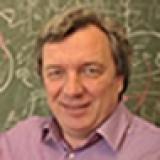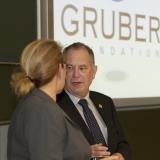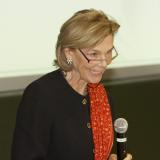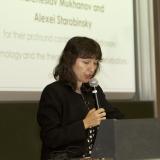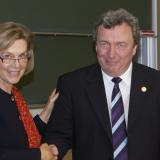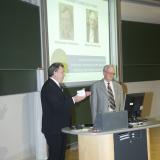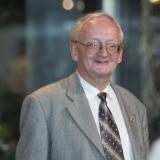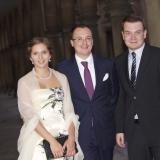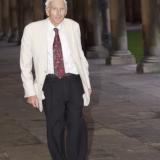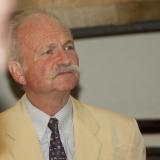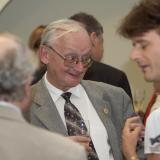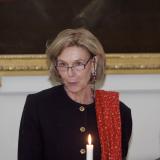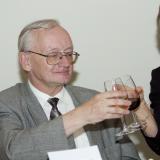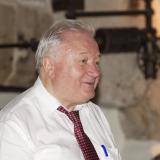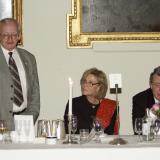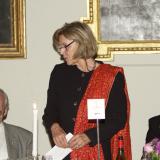2013 Gruber Cosmology Prize
During a heady period in the development of the Standard Cosmological Model, Viatcheslav Mukhanov and Alexei Starobinsky provided theories necessary to answer two of the fundamental questions of cosmology: Why is the structure of the universe so uniform on the largest scales? Where did the departures from that uniformity—such as galaxies, planets, and people—come from?
2013 Cosmology Prize Recipients
Laureate Profile
In 1979, the universe was in trouble—at least from a cosmologist’s point of view. Compelling evidence for the Big Bang theory—an interpretation of the universe as expanding over time—dated only to the mid-1960s. But already theorists found themselves confronting a problem that threatened to undermine that theory: Why is the universe so uniform, or homogeneous, on scales much greater than the size of its largest structures—the web of superclusters of galaxies that span hundreds of millions of light-years (a light year being the distance light travels in a year, or about 6 trillion miles)?
According to the Big Bang theory, galaxies on the whole are being carried away from one another on the expansion of space itself, so that no matter where you are in the universe, the rest of the universe seems to be receding from you. Yet if you look at the most distant part of the universe in one direction, and the most distant part of the universe in the opposite direction, they will be remarkably similar. They’re billions of light years apart, double the distance that light or any other kind of information could have traveled since the Big Bang, so how could they “know” to be alike?
Alexei Starobinsky, then a senior researcher at the Landau Institute for Theoretical Physics in Moscow, wasn’t working on that problem, but he helped to solve it anyway. He had been trying, instead, to figure out how the origin of a Big Bang universe might have worked, a task that took him down the rabbit hole of quantum gravity—the attempt to combine quantum mechanics and the general theory of relativity. In 1979, he discovered that the universe could have gone through an extraordinarily rapid exponential expansion in the first moments of its existence. In the same year he calculated the generation of gravitational waves during this exponential expansion.
The work of Starobinsky didn’t immediately reach beyond the Soviet Union. Shortly after it, the American physicist Alan Guth proposed a brilliant idea that the stage of the exponential expansion of the early universe, which he called “inflation,” could explain the incredible uniformity of our universe and resolve many other outstanding problems of the Big Bang cosmology. This clarified a potential significance of the regime of the exponential expansion. However, Guth immediately recognized that his proposal had a flaw: the world described by his scenario would become either empty or very non-uniform at the end of inflation. This problem was solved by Andrei Linde, who introduced several major modifications of inflationary theory, such as “new inflation” (later also developed by Albrecht and Steinhardt), “chaotic inflation”, and “eternal chaotic inflation.” A new cosmological paradigm was born. In 2004, Guth and Linde received the Gruber Cosmology Prize for the development of inflationary theory.
Starobinsky’s work inspired two of his fellow theoreticians in Moscow, Viatcheslav Mukhanov and G. V. Chibisov (now deceased). While an exponential expansion of a newborn universe would explain the large-scale homogeneity we see today, Mukhanov and Chibisov also realized that Heisenberg’s uncertainty principle prohibits absolute homogeneity.
“There would always remain small wiggles, or small inhomogeneities, in the distribution of the matter,” Mukhanov explains. “But normally these kinds of inhomogeneities are extremely small.” What would have happened, Mukhanov and Chibisov wondered, to the inhomogeneities that were present during the exponential expansion? In 1981, Mukhanov and Chibisov concluded that the exponentially rapid expansion would stretch tiny quantum fluctuations to an enormously large size. After that, these fluctuations would grow in amplitude and become the seeds for the galaxy formation.
“We were thinking we could take these small inhomogeneities and amplify them in the expanding universe,” Mukhanov says. He and Chibisov concluded that in a certain sense these primordial wiggles would be the universe today: the things that make the universe inhomogeneous on smaller scales; the structures that make the universe more than empty space.
In 1982, several scientists, including Starobinsky, outlined a theory of quantum fluctuations generated in new inflation. This theory was very similar to the theory developed by Mukhanov and Chibisov in the context of the Starobinsky model. Investigation of inflationary fluctuations culminated in 1985 in the work by Mukhanov, who developed a rigorous theory of these fluctuations applicable to a broad class of inflationary models, including new and chaotic inflation.
Later, cosmologists calculated how those inhomogeneities would appear in the cosmic microwave background (CMB), the relic radiation dating to the moment when the universe was 380,000 years old. At that time, hydrogen atoms and photons (packets of light) decoupled, leaving a kind of “flashbulb” image that pervades the universe to this day. Since then, numerous observations of the CMB have found an exquisite match with Mukhanov and Chibisov’s theoretical predictions, most recently in the release of data from the European Space Agency’s Planck observatory.
“When the mechanism of the creation of galaxies from quantum fluctuations was first proposed, it looked like a piece of science fiction,” says Andrei Linde. Today their work, as well as the work of other theorists in the late 1970s and especially the early 1980s, is widely accepted as the most reasonable—and most verifiable—explanation of the large-scale structure of the universe: It started with tiny quantum fluctuations subsequently blown up to cosmological scales by inflation.
Watch Video
Citation
The Gruber Foundation proudly presents the 2013 Cosmology Prize to Viatcheslav Mukhanov and Alexei Starobinsky for their profound contribution to inflationary cosmology and the theory of inflationary perturbations of the metric. These developments changed our views on the origin of our universe and on the mechanism of formation of its structure.


